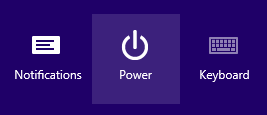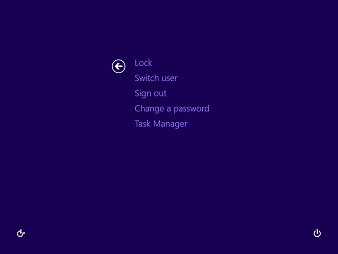How to Shut Down or Restart Windows 8
![]() This article covers Windows 8 and Windows 8.1 only.
This article covers Windows 8 and Windows 8.1 only.
![]()
![]()
![]() Click here for the article on How to Shut Down or Restart Windows for Windows 7 and earlier.
Click here for the article on How to Shut Down or Restart Windows for Windows 7 and earlier.
Introduction
This article will show you how to shut down or restart your computer, laptop, or device running Microsoft Windows 8. In short:
- Shut down turns off the computer or device completely.
- Restart turns it off and immediately turns it back on and starts Windows again.
Both of these actions will log off all users that are logged on at the time, forcibly closing all application programs. Windows will then save its system data, and close the Windows program itself properly, before shutting down the computer. When you initiate a shut down correctly as described below, Windows will also notice if you have any files open that haven't been saved, and prompt you to save them before it continues shutting down. But, it won't do this for any other users that are logged on at the time (such as through Remote Desktop), so you should tell anyone who might have anything open on your computer before you shut it down.
Below are details about each option, and how to do it in Windows 8. Click the links below to jump to the section you need.
Note: These instructions assume you are signed in already, to avoid having this page get too cluttered. You may notice the power icon on the screen while you're signed out or the computer is locked, which you can use to shut down or restart, similar to how you do it while signed in.
About Shutting Down
Shutting down properly allows Windows to sign off all active user accounts and clean up everything else it's doing, and then power down the computer. You should do this with a desktop computer if you ever need to unplug it (such as when there is a planned power outage in the building, or you need to move the computer). You never really need to do this with a modern laptop or tablet, so long as you charge the battery regularly. If you're going to put your laptop or tablet away for a long time, though, you should shut it down so the battery doesn't die.
When you shut down in Windows, this is referred to as a graceful shutdown, because Windows is allowed to close programs and save data properly. In contrast, if you just pull the plug on a desktop computer, this could possibly cause corruption of the programs or data because Windows was not able to close your programs and files properly.
In Windows 8, as opposed to prior versions, shutting down Windows does not actually shut down Windows completely. By default, it logs off all users, then saves the active state of every Windows program component to a file on your hard drive, then shuts off the computer. This is known as hibernation, and it's done to enable Windows to start up faster next time you turn on your computer. If you want to force a full shut down of Windows, to ensure Windows loads fresh next time you start, hold down the Shift key when following the instructions below for shutting down your computer using the mouse. None of this applies if you perform a restart, by the way, because Windows is always fully shut down and reloaded when you restart.
If you have a Windows 8 tablet (such as a Microsoft Surface, Dell Venue, Acer Iconia, Asus VivoTab, HP Omni, Toshiba Encore, or Lenovo IdeaTab), you should use the power button on the edge of the device to shut down and/or restart Windows. The instructions in this article for touch, keyboard, and mouse may or may not apply, depending on how your tablet manufacturer has configured Windows.
About Restarting
The Restart option shuts down Windows, turns off your computer or device, and immediately turns it back on and starts Windows, bringing you to the sign-in screen to start a fresh computing session. You typically do this if the computer or Windows itself seems to be malfunctioning, in hopes that clearing the working memory and starting it up fresh will fix it.
If your computer has a reset button on the front panel, you should avoid ever using this, as it has no connection with Windows and will immediately restart the computer, without giving Windows a chance to sign off users or clean up properly.
How to Shut Down or Restart in Windows 8
Quick Links in this section:
Using the Power Button 
The power button is the one with this symbol ![]() . It is not simply a mechanical switch that cuts off power. On desktop computers, pressing this button will tell Windows to initiate a proper Windows shut down (unless Windows has been reconfigured to do something else; how to do this is outside the scope of this article). If the button is easy to reach (that is, your computer isn't under a desk or something), then test it: close all your programs and press the button on your computer, then watch the screen carefully to see what happens. You should see a message that Windows is logging off, then a message that it's shutting down, and then it should shut off completely. If it does anything else, or you're not sure, then use another method listed on this page to shut down your computer.
. It is not simply a mechanical switch that cuts off power. On desktop computers, pressing this button will tell Windows to initiate a proper Windows shut down (unless Windows has been reconfigured to do something else; how to do this is outside the scope of this article). If the button is easy to reach (that is, your computer isn't under a desk or something), then test it: close all your programs and press the button on your computer, then watch the screen carefully to see what happens. You should see a message that Windows is logging off, then a message that it's shutting down, and then it should shut off completely. If it does anything else, or you're not sure, then use another method listed on this page to shut down your computer.
You can use this button to restart, of course. After the computer shuts down, just press the power button again to turn it on. As mentioned above, though, if your computer has a separate restart button apart from the power button, avoid using this, as it has no connection with Windows and will immediately restart the computer, without giving Windows a chance to sign off users or clean up properly
Using Touch 
This only works, of course, on a computer with a touch-capable screen. Here are the steps:
Swipe from the right edge of the screen to get the Charms bar (pictured right, half size), then tap the Settings tile.
In the row of tiles that appears, shown below, tap Power.

Tap Shut down or Restart from the menu that pops up.
If you have the April 2014 updates installed on Windows 8.1, you will notice the power icon appears next to your name on the Start screen, as pictured here.

So, if you happen to be on the Start screen already and want to shut down or restart, you can easily do it using touch only by tapping on that icon, and tapping Shut down or Restart from the menu that pops up.
Using the Mouse 
![]() Windows 8.1 only
Windows 8.1 only
Move the mouse to the bottom-left corner of the screen and right-click. A menu will appear. Select Shut down or sign out, then Shut down or Restart.
![]() Windows 8 or Windows 8.1
Windows 8 or Windows 8.1
Move the mouse into the top-right or bottom-right corner of the screen to get the Charms bar (pictured right, half size), then click the Settings tile.
In the row of tiles that appears, shown below, click Power.

Click Shut down or Restart from the menu that pops up.
If you have the April 2014 updates installed on Windows 8.1, you will notice the power icon appears next to your name on the Start screen, as pictured here.

So, if you happen to be on the Start screen already and want to shut down or restart, you can easily do it using the mouse only by clicking on that icon, and clicking Shut down or Restart from the menu that pops up.
Using the Keyboard 
![]() Windows 8.1 only
Windows 8.1 only
To shut down: Press ![]() +X, U, U.
+X, U, U.
To restart: Press ![]() +X, U, R.
+X, U, R.
If you have an older keyboard, the Windows logo key might look like ![]() or
or ![]() , but it will function the same.
, but it will function the same.
![]() Windows 8 or Windows 8.1
Windows 8 or Windows 8.1
Press CtrlAlt+Del. Wait until the screen switches to something like the image below, then press Alt+S. A menu will pop up. Use ⇧ to highlight Shut Down or Restart, then press Enter.

Shut down or restart when Windows is non-responsive
If clicking things with the mouse or pressing keys on your keyboard doesn't do anything in Windows, then you will have no choice but to forcibly shut down your computer. Here is what to do:
If your computer has a reset button on the chassis, just press this. That will always work, and immediately restart your computer.
If not, then press and hold the power button on the computer chassis for four seconds. It's the one with this symbol on it: ![]() . This causes a signal that goes directly to your computer hardware and tells it to shut off.
. This causes a signal that goes directly to your computer hardware and tells it to shut off.
Related articles:
Sleep, stand-by, and hibernation for your Windows based computer